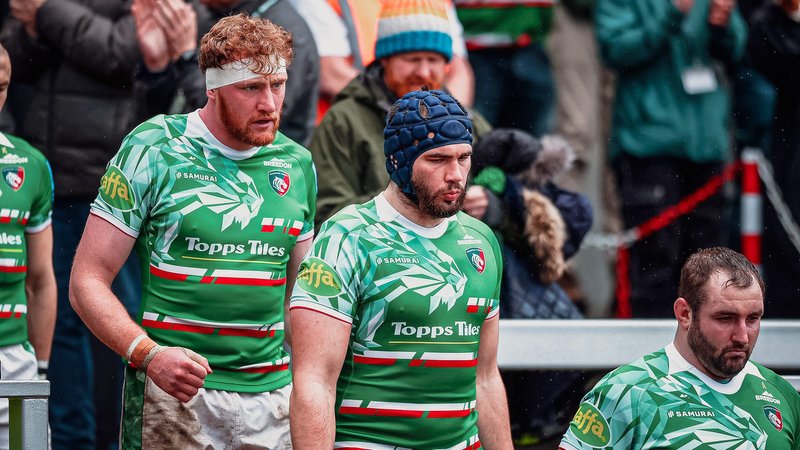Premiership Rugby has today backed a set of new measures that have strengthened World Rugby's commitment to injury prevention by announcing details of a zero-tolerance approach to contact with the head.
Following a research programme examining 600 incidents in 1,516 elite-level matches globally between 2012 and 2015, World Rugby has redefined illegal tackle categories and increased sanctions to deter high tackles via a law application guideline.
From this Friday minimum on-field sanctions will be introduced for reckless and accidental contact with the head, effectively lowering the acceptable height of the tackle. The guideline will be supported with a global education programme and applied at all levels of the game, including Aviva Premiership Rugby.
While injuries in the game are not on the rise, World Rugby continues to be proactive in furthering evidence-based strategies to reduce injury risk for all players.
The approach, approved by the World Rugby Council after expert, independent and union evaluation, combines with new disciplinary sanctions and a re-focus of match officials on dangerous play. It will provide a package of measures that aims to continue to change culture in the sport to ensure that the head is a no-go area.
Phil Winstanley, rugby director at Premiership Rugby, praised the initiative as a ‘step forward’ for the game and hopes the new directives will further bring about a positive culture shift that is already underway in the sport.
"It has to be a step forward for the game, we have to reduce the number of head injuries where possible,” Winstanley said. “We have to take action and this is the right step to take.
“We saw with tip tackles a few years ago that if you increase sanction, it acts as a deterrent and leads to a change in behaviour. I very much support it.
“As a sport and certainly within Premiership Rugby, we have made significant progress and significant investment in our attempts to identify the point of injury for head injuries and concussions.
“We also have some extremely well qualified and diligent medical teams that deal with the aftermath, treatment and return to play.
“It follows that as a sport we need to reduce the number of potential contacts that we have. We welcome the changes that have been made and understand why the changes have been made.
“The challenge we have is that in a physical contact sport, not all injuries are caused by a deliberate act of foul play or reckless behaviour.
“For the good of the players, coaches and match officials, we need to be able to establish where the parameters are.”
Statement from World Rugby:
World Rugby has further strengthened its commitment to injury prevention by announcing details of a zero-tolerance approach to reckless and accidental head contact in the sport. While injuries in the game are not on the rise, the federation continues to be proactive in furthering evidence-based strategies to reduce injury risk for all players.
In a change to law, World Rugby has redefined illegal (high) tackle categories and increased sanctions to deter high tackles via a law application guideline. This will apply at all levels of the game from 3 January 2017 introducing minimum on-field sanctions for reckless and accidental contact with the head, effectively lowering the acceptable height of the tackle. The guideline will be supported with a global education programme.
The approach, approved by the World Rugby Council after extensive expert, independent and union evaluation, combines with new disciplinary sanctions and a re-focus of match officials on dangerous play. It will provide a package of measures that aims to change culture in the sport to ensure that the head is a no-go area.
Two new categories of dangerous tackles have been introduce and will carry penalty offences to deter and eradicate high tackles:
Reckless tackle
A player is deemed to have made reckless contact during a tackle or attempted tackle or during other phases of the game if in making contact, the player knew or should have known that there was a risk of making contact with the head of an opponent, but did so anyway. This sanction applies even if the tackle starts below the line of the shoulders. This type of contact also applies to grabbing and rolling or twisting around the head/neck area even if the contact starts below the line of the shoulders.
Minimum sanction: Yellow card
Maximum sanction: Red card
Accidental tackle
When making contact with another player during a tackle or attempted tackle or during other phases of the game, if a player makes accidental contact with an opponent's head, either directly or where the contact starts below the line of the shoulders, the player may still be sanctioned. This includes situations where the ball-carrier slips into the tackle.
Minimum sanction: Penalty
Disciplinary Panels have been alerted to the revised World Rugby Regulation 17 sanctions. Specific changes to Law 10.4(e) Dangerous tackling of an opponent has been highlighted below.
10.4(e) Dangerous tackling of an Opponent including: (i) a tackle or attempted tackle above the line of the shoulders even if the tackle starts below the line of the shoulders; (ii) grabbing and rolling/twisting around the head/neck area even if the contact starts below the line of the shoulders.
LE – 2 weeks
MR – 6 weeks
TE – 10+ weeks
A dangerous tackle which results in a strike to the head shall result in at least a mid-end entry point sanction 52 weeks.
Click here to see an educational video on this subject.
Following a research programme examining 600 incidents in 1,516 elite-level matches globally between 2012 and 2015, World Rugby has redefined illegal tackle categories and increased sanctions to deter high tackles via a law application guideline.
From this Friday minimum on-field sanctions will be introduced for reckless and accidental contact with the head, effectively lowering the acceptable height of the tackle. The guideline will be supported with a global education programme and applied at all levels of the game, including Aviva Premiership Rugby.
While injuries in the game are not on the rise, World Rugby continues to be proactive in furthering evidence-based strategies to reduce injury risk for all players.
The approach, approved by the World Rugby Council after expert, independent and union evaluation, combines with new disciplinary sanctions and a re-focus of match officials on dangerous play. It will provide a package of measures that aims to continue to change culture in the sport to ensure that the head is a no-go area.
Phil Winstanley, rugby director at Premiership Rugby, praised the initiative as a ‘step forward’ for the game and hopes the new directives will further bring about a positive culture shift that is already underway in the sport.
"It has to be a step forward for the game, we have to reduce the number of head injuries where possible,” Winstanley said. “We have to take action and this is the right step to take.
“We saw with tip tackles a few years ago that if you increase sanction, it acts as a deterrent and leads to a change in behaviour. I very much support it.
“As a sport and certainly within Premiership Rugby, we have made significant progress and significant investment in our attempts to identify the point of injury for head injuries and concussions.
“We also have some extremely well qualified and diligent medical teams that deal with the aftermath, treatment and return to play.
“It follows that as a sport we need to reduce the number of potential contacts that we have. We welcome the changes that have been made and understand why the changes have been made.
“The challenge we have is that in a physical contact sport, not all injuries are caused by a deliberate act of foul play or reckless behaviour.
“For the good of the players, coaches and match officials, we need to be able to establish where the parameters are.”
Statement from World Rugby:
World Rugby has further strengthened its commitment to injury prevention by announcing details of a zero-tolerance approach to reckless and accidental head contact in the sport. While injuries in the game are not on the rise, the federation continues to be proactive in furthering evidence-based strategies to reduce injury risk for all players.
In a change to law, World Rugby has redefined illegal (high) tackle categories and increased sanctions to deter high tackles via a law application guideline. This will apply at all levels of the game from 3 January 2017 introducing minimum on-field sanctions for reckless and accidental contact with the head, effectively lowering the acceptable height of the tackle. The guideline will be supported with a global education programme.
The approach, approved by the World Rugby Council after extensive expert, independent and union evaluation, combines with new disciplinary sanctions and a re-focus of match officials on dangerous play. It will provide a package of measures that aims to change culture in the sport to ensure that the head is a no-go area.
Two new categories of dangerous tackles have been introduce and will carry penalty offences to deter and eradicate high tackles:
Reckless tackle
A player is deemed to have made reckless contact during a tackle or attempted tackle or during other phases of the game if in making contact, the player knew or should have known that there was a risk of making contact with the head of an opponent, but did so anyway. This sanction applies even if the tackle starts below the line of the shoulders. This type of contact also applies to grabbing and rolling or twisting around the head/neck area even if the contact starts below the line of the shoulders.
Minimum sanction: Yellow card
Maximum sanction: Red card
Accidental tackle
When making contact with another player during a tackle or attempted tackle or during other phases of the game, if a player makes accidental contact with an opponent's head, either directly or where the contact starts below the line of the shoulders, the player may still be sanctioned. This includes situations where the ball-carrier slips into the tackle.
Minimum sanction: Penalty
Disciplinary Panels have been alerted to the revised World Rugby Regulation 17 sanctions. Specific changes to Law 10.4(e) Dangerous tackling of an opponent has been highlighted below.
10.4(e) Dangerous tackling of an Opponent including: (i) a tackle or attempted tackle above the line of the shoulders even if the tackle starts below the line of the shoulders; (ii) grabbing and rolling/twisting around the head/neck area even if the contact starts below the line of the shoulders.
LE – 2 weeks
MR – 6 weeks
TE – 10+ weeks
A dangerous tackle which results in a strike to the head shall result in at least a mid-end entry point sanction 52 weeks.
Click here to see an educational video on this subject.







